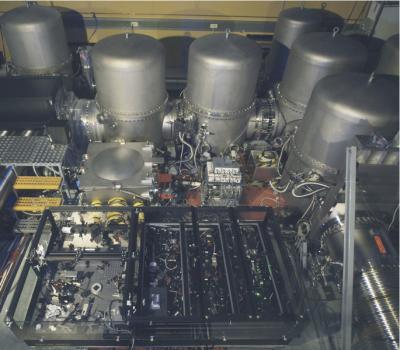Measuring at the limits of the laws of nature – this is the challenge which researchers repeatedly take up in their search for gravitational waves. The interferometers they use here measure with such sensitivity that a particular quantum phenomenon of light – shot noise – limits the measuring accuracy. With the "squeezed light" method scientists from the Max Planck Society and the Leibniz University Hannover likewise use quantum physics in a countermove in order to remove the interfering effect.
The new type of laser light improves the measuring accuracy of the gravitational wave detector GEO600 by around 50 percent and thus increases its effective sensitivity. This is the first time this technology has been used outside of a test laboratory anywhere in the world. The results were in Nature Physics.
Some 50 years after the development of the first lasers, the technology of "squeezed light" can be used to generate a completely new quality of laser light. The light from a squeezed laser radiates much more calmly than light from a conventional laser source. "Thanks to the squeezed laser, we were able to increase the measuring sensitivity of GEO600 to 150%," says Hartmut Grote, who heads the detector operation. "The new light source fulfils all requirements as expected."
In future, this technology could be used to even double the measuring accuracy. In the search for the almost undetectable gravitational waves, this increase in sensitivity is an important step to their direct detection.
The GEO600 experiment at the QUEST (Center for Quantum Engineering and Space-Time Research) Cluster of Excellence is part of the international LIGO Virgo Collaboration (LVCon) and is putting the researchers from the Max Planck Institute for Gravitational Physics (Sub-Institute Hanover, Albert Einstein Institute/AEI) and from the Institute for Gravitational Physics at the Leibniz University Hannover on the track of gravitational waves. Einstein predicted these oscillations in space-time around a hundred years ago in his General Theory of Relativity. They arise during turbulent cosmic events such as supernova explosions, for example.
Gravitational waves are scarcely noticeable on Earth, however. One reason is that the interaction between matter and space is very weak. Changes to the structure of space-time which occur in our immediate astronomical vicinity as a result of the movements of relatively low-mass objects, such as moons or planets, are way below what is measurable. Turbulent supernova explosions which violently shake space-time occur at a great distance, in contrast. The gravitational waves generated in the process are considerably attenuated when they reach Earth. The relative measuring path in a gravitational wave detector would change by only around a thousandth of a proton diameter if a supernova occurred within our Milky Way. With GEO600, the scientists are meanwhile able to measure such differences in length.
Laser light with constant intensity
In order to be able to make such accurate measurements, the physicists must rely on metrology techniques that are as free from interferences as possible. One of the effects which has caused interference so far is the so-called shot noise. Their quantum nature means the photons rain down at irregular intervals onto the photodiode in the detector. This is evident in the signal as fluctuating background brightness. An oscillation of space-time which causes a similarly weak change in the brightness like the shot noise, can thus only be recognised with difficulty.

The new squeezed light laser of GEO600. A highly complex laser system produces light which particularly quiet in the gravitational wave detector.
(Photo Credit: © Max Planck Institute for Gravitational Physics (Hannover))
Roman Schnabel and his research group in Hannover have now developed a special light source with which the disturbing shot noise can be curbed. When integrated into GEO600, the squeezed light laser assists the gravitational wave detector to a new measuring sensitivity. This makes the GEO600 the first detector whose signal beam is smoothed with the new type of laser light.
The Heisenberg uncertainty principle states that the intensity and colour of a laser beam cannot simultaneously be defined with arbitrary accuracy. For example, the more exact the intensity (to be more precise: the amplitude) is specified, the more uncertain the colour becomes (to be more precise: the phase). The quantum physicists utilise this effect to minimise the shot noise in the GEO600 experiment. After all, the shot noise is actually nothing more than an uncertainty of the laser intensity. They improve the laser light so that its intensity is very accurately defined, i.e. exhibits almost no fluctuations. The experts also call this process "squeezing". In this experiment, it is of no consequence that the light colour becomes more imprecise, i.e. slightly more "colourful", since this parameter is not included in the measurement data.
"We now feed the squeezed light into the interferometer, in addition to our normal laser light," explains Schnabel. "If the two light fields then superimpose, the resulting laser beam has a much more uniform intensity, compared to the original signal beam. "We thus smooth out the irregularities caused by quantum physical effects in the detector signal," Schnabel continues.
The squeezed light laser has been undergoing a longer test phase since April last year at GEO600 and is now being used in the search for gravitational waves. The application of squeezed light technology has thus passed the acid test. The American colleagues within the LVC plan to soon test a squeezed laser on the LIGO detectors.
Source: Max-Planck-Gesellschaft